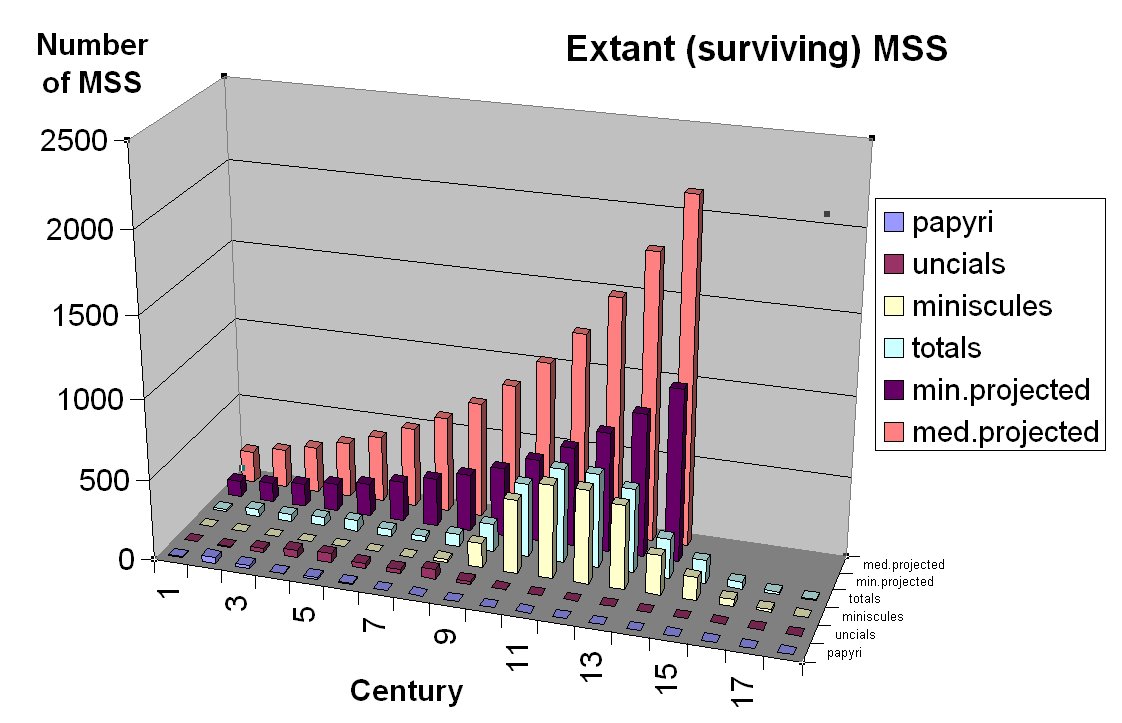
Exerpted from: Nazaroo, Previously Unconsidered Evidence,
forum thread
(www.christianforums.com, 2007)
Background
When we look at the numbers of surviving manuscripts, we come across something very strange. Instead of following the normal exponential shape of curve for manuscript multiplication through copying, there is a huge gap of missing manuscripts for the period from the 4th to the 9th century.
The following chart has been plotted using the latest data on the dates and MSS counts for the entire NT period, century by century, put together by Maurice Robinson and posted on the internet:
MSS List compiled by Maurice Robinson

What happened to all the manuscripts that were made between the 4th and 9th centuries?
One explanation is as follows:
"The Roman Emperor and the new 'Holy Roman Empire' destroyed them all, while trying to impose their own text.
This would be the text without John 8:1-11, because Emperor Constantine in a fit of jealous rage murdered his own son wrongly for committing adultery with his queen, then boiled his queen to death for Adultery."
No hard feelings there... And yet this seems too simplistic to explain five centuries worth of missing manuscripts.
Another explanation goes as follows:
"As time goes on, the more the manuscripts are preserved."
Unfortunately, statements like this do nothing to explain the actual state of the manuscripts.
Of course the rate of increase of manuscripts can and will be affected by expansion of copying centers, improved copying techniques, and even fluctuations in economic factors (droughts, taxes, wars, plagues.) Finally anomalies in local climates (such as the dryness of Egypt) can affect raw numbers of surviving manuscripts for key periods.
But none of these factors explain the data at hand.
Problems with the Proposed Theories
NO variation in the rate of increase of manuscripts can cause a NEGATIVE rate of increase. Even if manuscript production were to stop dead for a short period, the number of manuscripts, and the rate of multiplication will always have a slope that is between zero and a positive number.
Only the destruction of existing manuscripts can cause a decrease in the actual number of manuscripts for any given short window of time or snapshot from the timeline, which would show up as a negative rate of increase.
But you can only destroy manuscripts which are already in existance, not manuscripts that have not been written yet, or counted.
Nor do any of the listed factors have any power to cause the actual raw number of manuscripts for each century (and a century is a VERY long period for copying manuscripts) to drop. Only DESTRUCTION of manuscripts of a specific age can cause this.
Some Things Can be Accounted For
When we see the Papyri increasing, then decreasing in absolute numbers, the explanation is simple: Copying is a multiplicative process, accounting for the increase.
The practice of making papyri was phased out when resources and techniques arrived for the more durable parchment making. This accounts for the later decrease in papyri. There was an active conscious choice which transferred preference to parchments.
Other Problems Don't Disappear
There is no such process available for UNCIALS/Miniscules. These are merely different forms of handwriting on the same materials. Physically the manuscripts must be lumped together. And now, the problem is clearly apparent.
There can be no talk of a 'decrease in uncials', with a corresponding 'increase in miniscules' during an entirely different period FIVE WHOLE CENTURIES LATER. A mere change-over in writing technique would simply transfer the production count to the newer style.
The Crux of the Problem
Its the DIP in the ABSOLUTE number of surviving manuscripts for each period that must be explained. The techniques of manufacture didn't deteriorate. The climate didn't change. In fact, as Robinson et al have noted, production INCREASED.
The quality of manuscripts was already good enough to easily survive till the present from the 4th century onward. To put it bluntly, manuscripts from the 6th, 7th, 8th, and 9th centuries are hardy and durable objects, meant to survive abuse and withstand deterioration, and they were adored and cared for in dry libraries, churches and monasteries, and were looked after carefully by librarians, monks, scribes.
There can be no explanation for the missing manuscripts from the 4th to the 9th centuries, other than wilfull gathering and destruction on a massive scale.
Even Maurice Robinson is painfully aware of this problem, and must conjecture a wholescale 'procedure' that involves recopying and DESTROYING the exemplars. This is to account for the huge number of manuscripts from all over the empire in the 9th, 10th, 11th, 12th, 13th, centuries, and yet the fact that we have virtually NO SURVIVING MANUSCRIPTS FOR THE PREVIOUS FIVE CENTURIES.
A handful (less than a few hundred uncials and fragments) simply won't adequately cover this relatively recent period.
FIVE CENTURIES WORTH OF MANUSCRIPTS ARE MISSING
The handful of 'approved' MSS from the 4th and 5th centuries had no trouble surviving on the bookshelves of the Vatican and in various monasteries throughout the Mediterranean. This just means what we expect: a handful of ancient MSS somehow escaped destruction. But this only makes sense against a background of massive wholesale destruction.
Since there is a plethora of MSS from the 9th century forward, this massive operation of destruction must have stopped after five centuries of destruction.
The only other option is one late 'pogrom' of destruction in the 9th century that virtually wiped out all old MSS, but somehow left a remnant (hidden from the destroyers) from which the Christians were able to recover and replenish the supply.
But even this theory falls upon its face, because then there should be a large number of 'seed' manuscripts from which the mass of 5,000 manuscripts dating from the 10th to the 15th century were copied. Some of those should have been UNCIALS of various ages, covering the whole period targeted by previous persecution and destruction.
The only explanation for the missing manuscripts is something like Maurice Robinson has proposed: namely that those replenishing the MSS supply were the same people who destroyed the MSS from whence they were copying, ensuring no trace of their sources.
No Record of the Practice of MSS Destruction
Yet there is one more problem with such an explanation:
There is no such procedure of 'destroying the MSS you are copying from', that has been recorded throughout the history of a whole millenium of copying.
This has to have been a practice which was almost universally, but SILENTLY adopted by the scribes themselves, and with little protest or rebellion (or else severe punishments).
And the mystery seems really to be solved:
"The church destroyed its own manuscripts, as it did to the commentaries and homilies of its own doctors, each of whom was in turn declared a heretic and damned, and their works put to the flames. [see below for an account of this activity in this period.]
They made it illegal to make or possess your own copies of the Scriptures, and killed and tortured Jew and Christian alike who dared to preach their contents independantly. They abused the very power of govenment, of state, to impose control and enforce a standard which guaranteed their stranglehold over all other powers in Europe. This was the very cause of the Reformation.
The suppression of the Scriptures for FIVE centuries after the establishment of the 'Christian-Roman Empire', and the final escape and burst of copying activity in the following five centuries is the story of the suppression of true Christianity and religion by authoritarian dictatorship, and the final victory of the common working-class people over their rulers.
This was the prepatory PRE-REFORMATION, the necessary spread of the Gospel to the people BEFORE any Reformation could take place. The invention and spread of the power of the printing press was only the icing on the cake, the final reward for centuries of quiet extrication from the yoke of Rome.
Once the critical number of manuscripts and copy-centers was reached, the cat was out of the bag, and power of Rome broken. There was a brief attempt to reinstate this power during the Nazi occupation of Europe, but this was no longer Medieval Europe. The Dark Side, though vicious and dangerous, and immensely destructive, could not defeat the force of education and literacy, largely driven by sincere religious devotion and belief."
Yet there may be a much less radical solution to the problem, one that is based rather upon scientific and historical processes that are less sinister, and more natural than hitherto expected.
"In this theory, if the folks who willfully destroyed early uncial vellum manuscripts for doctrinal purposes, to keep away from sight the ancient texts, did not like the Byzantine readings in those manuscripts (e.g. Pericope Adultera) - why did they include those same readings in all the new minuscle copies they were making ?
The minuscles in Greek are uniformly Byzantine (in a general sense and large numbers of manuscripts). And in Syriac are a mostly Byzantine Text. And there is the mixed Latin Vulgate text and copying from the Old Latin line. The focus is mostly on the Greek but the others are significant too."
- from a post by Praxeus
This is an important aspect of the problem which must be adequately dealt with by any plausible history of the text. No proper or convincing theory for the missing MSS can leave out the fact of the preponderance of the Byzantine text-type.
The Essential Model
For our purposes at the moment, we can put aside the question of text, and just talk about the number of MSS and the engine which generates them over time. Just as people have 'free will' which is limited by overriding constraints (like gravity preventing them from flying), so in this case, the mechanisms involved impose serious limits to the potential of the process.
Our case of manuscript generation can be modelled along the lines of a simple 'stock market' system. That is, a basic production process which has a small amount of iterative feedback, allowing for a limited 'runaway growth'. This is a classic 'Fibonacci' style series, similar to rabbit reproduction and a 'life cycle' for individuals in the MSS population.
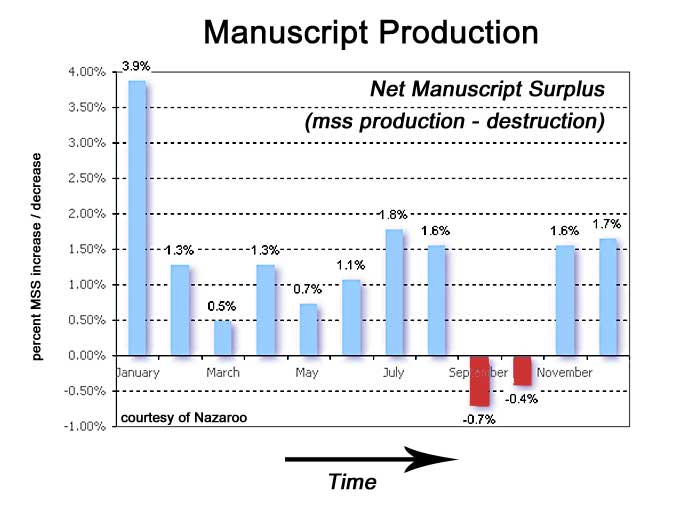
Here in the first graph we can see the net manuscript production, as a result of the amount of new MSS made, from which is subtracted the # of MSS worn out or destroyed over a given time period. There is obviously the potential for 'negative growth' over short bursts, when MSS production cannot keep up with MSS destruction for one reason or another. Most of the time however, MSS production will be greater than MSS loss.
Over these shorter periods, MSS production capacity will be relatively constant, limited by the number of production centers and available scribes, as well as the amount of resources available and scheduling of harvests (seasonal growth cycles for papyri) and slaughters (herding and butchering for meat and skins for parchment).
The effect of constant capacity over short time periods will be that fluctuations in production (measured best as a % of total MSS) will gradually be diminished by the ever increasing total numbers of MSS.
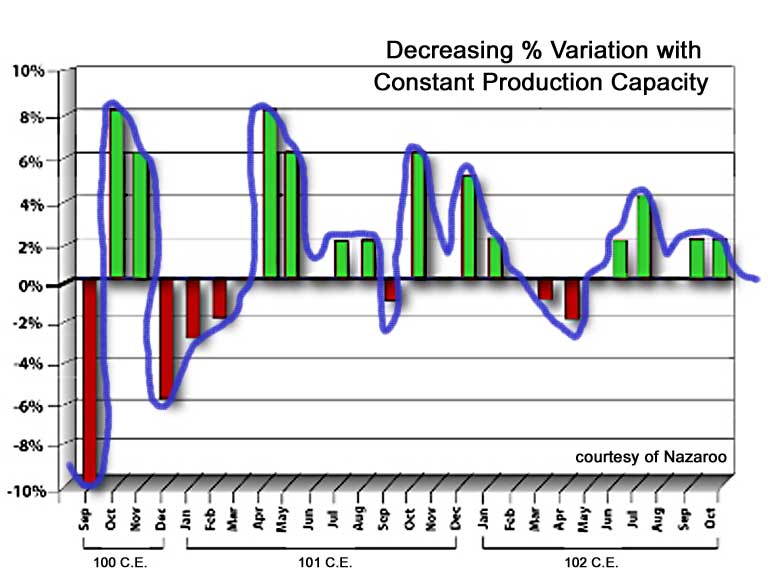
Just as in the simple Stock Market model, short term fluctuations and instabilites are absorbed and averaged out by longer term trends, in our case the steady increase in the total number of MSS.

In the long term however, the number of production centers and the quantity of MSS produced will increase alongside the expanding Christian population. This is a simple 'market driven' process, of supply and demand, limited by opportunity and resource management, and periodically affected by outside uncontrolled forces, like drought, short bursts of persecution, discovery of production centers or caches of MSS, and killing of key skilled personnel such as copyists. However, these short-term instabilities in production and catastrophic bursts of MSS destruction will have a typical 'stock-market' morphology. Recently, physicists have analysed the stock-market in terms of Catastrophy Theory and similar models, in order to spot signs of instability and predict follow-up trends.
For our purposes, the point of interest is the tell-tale 'Saw-Tooth' shape of the market plot. Whenever there is a local short-term burst of instability in the model (which could be either production failure or destruction of MSS in our case), a Saw Tooth fingerprint will appear in the long-term trend plot:
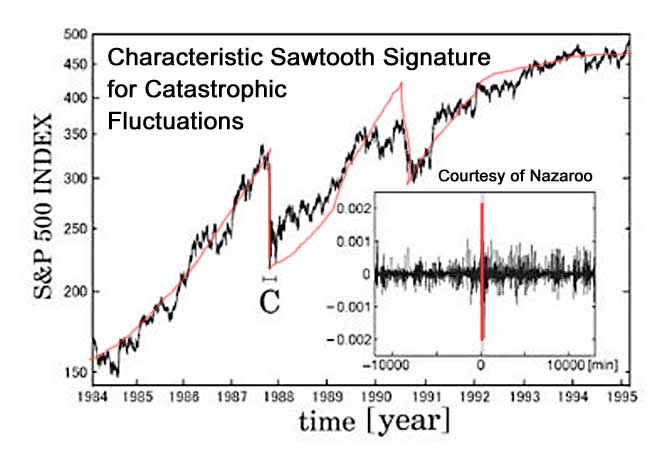
What is important to realise is that the typical kinds of 'catastrophe' have a distinct shape, which is determined by the nature of the feedback mechanisms of the model. It is not arbitrary but predetermined by the 'market' forces. In our even simpler case, variations from this pattern are even more difficult to produce.
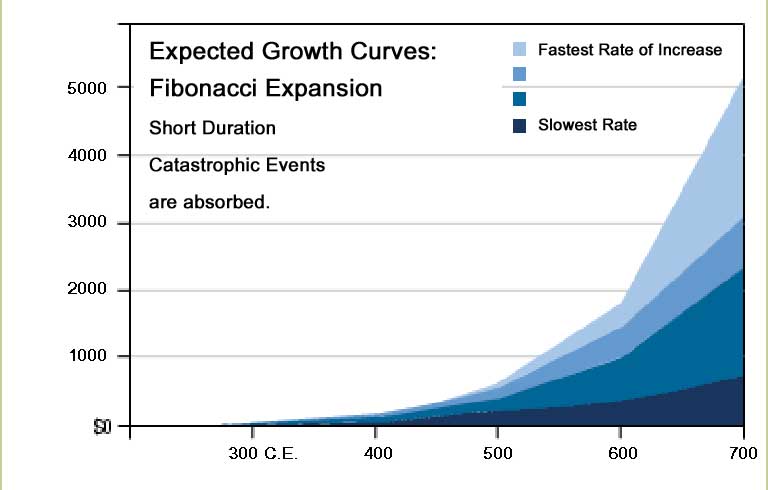
The key point is that even allowing for severe short-term catastrophes, the overall trends and final overall curve is still the same. The largest displacement of the standard expected Fibonacci curve will be a short 'blip' in the shape of a sawtooth.
And this is the thing. This is precisely what we DON'T see in the actual data for the extant MSS. Instead we see a footprint, a signature for an entirely different kind of process: a LONG TERM universal process, or else a short-term DIRECTED universal process against MSS of a specifically selected age range:
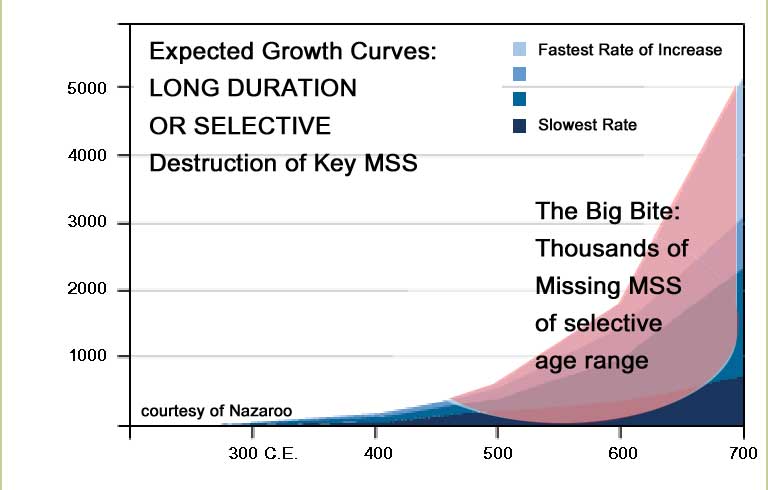
This can only imply one of two basic situations:
(1) Either MSS were systematically and universally destroyed over a long period, from about 400 A.D. to about 900 A.D., or else,
(2) MSS were selected at the end of this period (about 900 A.D.) and selectively destroyed by age-range as the criterion. In either case, this can only be a conscious, perpetrated and universal act of vandalism.
As to the choice of text which was destroyed, as Praxeus correctly points out, BOTH MSS with and without the PA were destroyed. There was no selection based upon the content or text-type, but rather age alone.
The Essential Transmission Process
The key thing to understand is that the copying and multiplying of MSS is a very simple Fibonacci process. There really is no 'choice of models' per se or the curves that will be generated. Remember we are here only modelling the physical copying process, not modelling the morphological or evolutionary changes to the actual text itself.
So the problem is just a simple 'curve-fitting' by stretching or compression along one axis or another to align it with the most reliable and complete parts of the data.
This allows us to extrapolate the existance (and rough sizing) of the missing data.
Thankfully, many things work in our favour to make the modelling reliable and reasonably accurate. For instance, the bulk of the late manuscripts are not hidden or unknown, but readily available and in the care of public museums, governments, religious institutions and private collectors. We don't even need access to the MSS themselves for things like a simple 'head count' for each century or rough dating-range.
Keeping in mind that the dating of MSS (unless they are actually dated internally) are + or - 50 years, using paleaontology. This sets up natural approximate segmentation into 'eras'.
Certain things then, like the approximate numbers of MSS copied in the last five centuries (1000 - 1500 C.E.) of copying are well known, and not in any serious dispute.
But the critical implications are provided by the copy process itself. Each known manuscript must have been copied from a previous one. So we can extrapolate backward rather confidently regarding the basic 'exponential' (Fibonacci) curve that must lie behind the known manuscripts from the late period. We are 'curve-fitting' against the most solid and reliable part of the data.
When other well-known factors (like the invention of 'moveable type' printing in 1500, and the decay and collapse of the Byzantine Empire) are taken into account, and these layers are peeled off of the raw number counts, we have a good idea of the size of the MSS count from the missing centuries prior to the 10th century.
Then when we compare the numbers of surviving MSS from the previous five centuries we can see quite clearly the approximate number of MSS which are actually missing, but are presupposed from the model and the physical copying process.
Final Questions Reviewed
One concern is the question of whether surviving MSS from the later centuries are representative of the previous process that produced them:
"Could the analysis be fallacious because the number of manuscripts we have for a given time period are only representative of what we have discovered and not necessarily representative in any proportional way to the number of manuscripts produced during that time period?"
This is a good question, but one that can be easily answered for the later centuries. Not only did the Greek copyists flee the Islamic hordes, but the majority of them came to live and work in the Holy Roman Empire, where many of them were accommodated and continued to ply their trade copying Greek MSS. Thus it is no real secret the number of MSS actually produced during this last 500 years. We are not likely to have missed very many.
Some 5% of these may have ended up in the private hands of a few wealthy European monarchs and Dukes, but even these have been for the most part returned or donated to museums in our era. An even smaller percentage may have been destroyed by accident or neglect, but this won't significantly affect the basic picture of hand-copying of Greek MSS in Europe during the last few centuries before the Reformation.
There really is no more scientific procedure feasible than working backward from the known to the unknown.
The basic facts are rather transparent. Many MSS (of which there must have been thousands made in each century) dating from the 5th to the 9th centuries are simply completely missing.
And this corresponds quite well to what we know of other NON-biblical MSS from this period. They are missing because they were destroyed by church authorities.
The problem is not really in the question of the fact that the MSS are missing. This is rather obvious. The real question is HOW and WHY they were destroyed, and by exactly whom?
And everything points to a church unwilling to release education to the masses, and unwilling and resistant to the process of reform and change that inevitably came with or without their help.
Its the basic story of the Grinch who stole Christmas, but who couldn't stop Christmas from coming, even though he burnt all the MSS.
... and yet, a simpler answer may serve as a partial explanation:
"It may be that as old uncial manuscripts were copied in the new, fashionable, minuscule script that the old fashioned originals were no longer thought worth the bother of carefully preserving."
- Andrew Criddle
This idea here is almost inconceivable, in the light of the extreme cost and value of used parchment. This material was recycled at every opportunity, because of its extreme expense, time, and difficulty in manufacture. What we know is that copyists would recycle anything they could get their hands on to save labour and resources.
And if any other fate is plausible it would rather be that older worn out copies would be gifted to poorer smaller churches or passed to missionaries working in the field, or given to families of church members. In this case, we should have expected that at least some several hundred uncials from every century would have survived, out of the thousands made.
This again is just sophistry, and goes against everything we know about the thinking and behaviour of early copyists. Jews, Jewish Christians, and even later Gentile Christian copyists treasured and carefully retired worn out MSS, as archeaological discoveries continue to demonstrate.
We continue to find "MSS burial grounds", places like caves, 'tombs', and sealed up walls filled with worn but carefully cherished and protected MSS, too frail to use, but that their owners were too reluctant to just throw away. The discovery of Codex Sinaiticus (and many other MSS) in a room under a collapsed roof is the paradigm of how ancient copyists in scriptoriums dealt with worn out MSS.
What has happened here in the 5th to the 9th century may simply be a part of a massive recycling program in the 9th or 10th century.
A kind of 'emergency recycling program'. It may be that perhaps many miniscule MSS yet to be more carefully examined may turn out to be palimpsests of previous Uncials sacrificed and simultaneously restored to circulation. In this case, we can presume that the text of the new 'Miniscules' is simply essentially the text of the recycled Uncials.
An explanation along these lines would go far in explaining both the ancient readings and the uniformity of text among the later Byzantine (traditional and popular) MSS of the 10th to the 15th centuries.
In this case, while most Uncials may have been sacrificed in a good cause; their texts were actually saved for the most part by re-surfacing and recycling of the best pages, while at the same time copyists were using their best representatives as master-copies or exemplars.
This may inadvertantly answer the mystery created by Praxeus' key questions, as best as they can be.